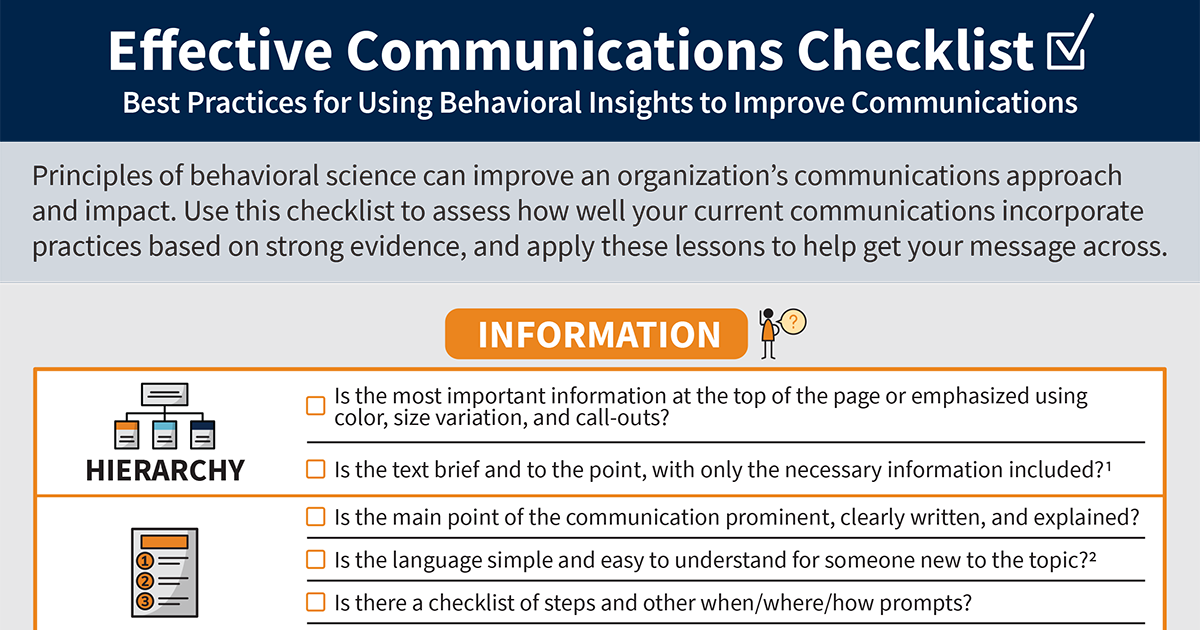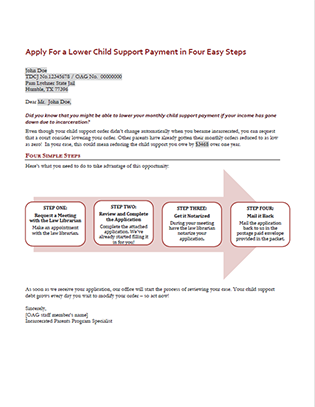Getting Your Message Across with the Effective Communications Checklist

Under normal circumstances, how much time and energy do you as program operators, administrators, or staff spend writing letters, emails, flyers, postcards, and text messages to clients? Are you spending even more time on these tasks during the COVID-19 pandemic, when many programs must rely on written communications in the absence of in-person meetings? Do you sometimes wonder: “Am I getting my message across?”
The Effective Communications Checklist can help. MDRC’s Center for Applied Behavioral Science (CABS) developed the checklist after testing varied approaches to communications about eligibility, enrollment, and attendance. In studies like the Behavioral Interventions to Advance Self-Sufficiency (BIAS) project, we worked with the Temporary Assistance for Needy Families (TANF) program and child care agencies that needed to communicate directly to clients. In this post, we share some key lessons from one of those studies and offer a communications guide you can adapt for your own needs.
The Effective Communications Checklist helps programs use findings from MDRC projects that applied behavioral science to improve program notices, reminders, and encouragements. This checklist focuses on three key goals of any communication:
- the information your client or partner should know;
- the motivation for why they should care; and
- the action they should take as a result of this communication.
Put your materials to the test!
Use the Effective Communications Checklist to measure how well your materials emphasize the right information, motivation, and action, and learn how to improve them.
Score your materials using the Effective Communications Checklist:
- Choose a script or written material to assess.
- Review each item on the checklist. For every box you can check, your material gets a point. How many total points does your material get?
- Review the boxes that are not checked and see where you can make improvements.
Some of the checklist items may not be possible for all communications, depending on your available time and resources. Set a goal of scoring at least a 12, or 4 per section, on average. For an especially important communication, try to go for all 20!
The checklist helps us focus on ways to improve communication with more than just visual design — by improving the content so your message is crystal clear. It’s especially important to ease the reader’s cognitive burden during moments of crisis. Program administrators, staff, and participants benefit when your communications are clear and actionable.
Here’s how it’s done. CABS worked with the Texas Child Support Agency in the (BIAS) project, sponsored by the Office of Planning, Research, and Evaluation in the Administration for Children and Families, to improve their communications using behavioral insights.[1] The examples below show the original letter (before) and the revised letter (after).
| BEFORE | AFTER |
|---|---|
|
CHECKLIST SCORE: 7/20 |
CHECKLIST SCORE: 14/20 |
The after letter reflects improvements based on each section of the Effective Communications Checklist. Here are examples that represent changes in each section of the before and after versions:
Information
Before
The main point is buried in the second paragraph and uses complex language: “Due to the change in your circumstances (incarceration), you may be eligible for a modification of your child support payment.”
After
The main point is the first line, in bold, italics, color, and large font — the reader can’t miss it: “Did you know that you might be able to lower your monthly child support payment if your income has gone down due to incarceration?”
Motivation
Before
The letter is impersonal, addressed to “Incarcerated Parent,” and does not include any personalized information about the reader’s situation.
After
The letter has many personalized details: the parent’s name, the potential dollar amount reduction in child support, and the connection to others in similar situations: “Other parents have already gotten their monthly orders reduced to as low as zero!”
Action
Before
The action steps are buried in the third paragraph, with complicated language like “upon receipt” and “custodial parent,” causing the reader to spend extra time understanding the next steps. The language also focuses on the agency’s actions rather than the parent’s actions.
After
The actions are listed in four clear steps, all of which focus on the parent perspective (opposed to the agency perspective). The agency even initiated the application step for the parent, potentially motivating the parent to act reciprocally: “Complete the attached application. We’ve already started filling it in for you!”

You try it
Practice using the Effective Communications Checklist in the before and after Texas Child Support letters. How many points does each version score?
To see the final results of the study in Texas (spoiler alert: it worked!), and more behaviorally informed materials for the successful BIAS sites, check out the Behavioral Intervention Materials Compendium.
If during this period of changing outreach methods, you find yourself calling people more than emailing them, you also can use the Effective Communications Checklist for verbal communications. The Effective Communications Checklist is a simple, evidence-based, behaviorally informed guide to improve your scripts as well as the materials you send.
We’d love to hear how this worked for you and how we can help! Email us with your before and after materials and your scores at cabs@mdrc.org.









